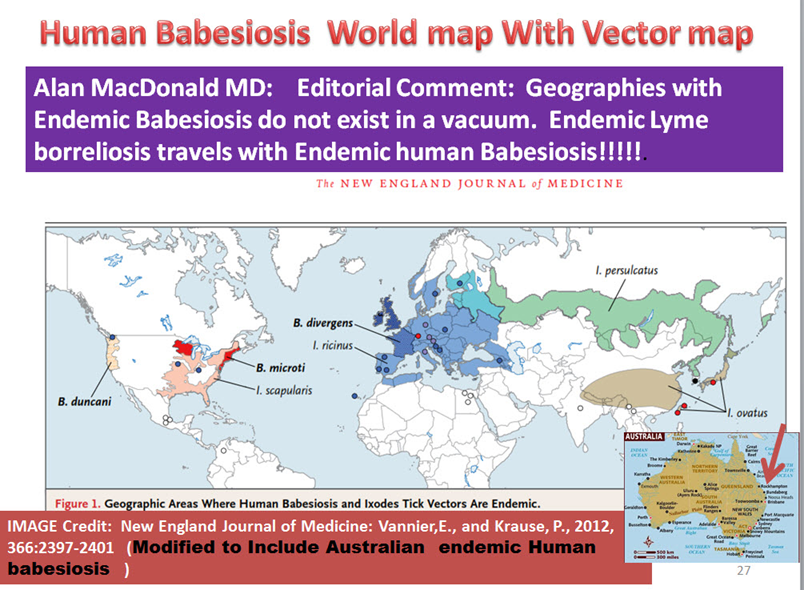About Babesia
Babesiosis is caused by an intraerythrocytic parasite, Babesia microti, and is one of the most common parasitic infections of free-living animals worldwide with a prevalence rate second only to trypanosomal infections. Picture: © and by permission from Alan MacDonald MD, USA
The pear-shaped, plasmodium-like organisms were first detected by Victor Babes in cattle suffering from febrile hemoglobinuria in 1888. Nearly 100 species within the genus Babesia have been described, of which several are capable of infecting humans. Human Babesiosis is a life-threatening, emergent tick-borne disease, caused primarily by Babesia microti, though human infections with Babesia gibsonii, Babesia WA1 and CA1 have also been reported. The prevalence of Babesia microti infection varies depending on the geographical region. Over the past 30 years, the United States have seen an increasing number of confirmed Babesiosis cases, presumably due to an increasing number of deer compounded by an increase in outdoor activities. An endemic Babesiosis was confirmed by the Centers for Disease Control and Prevention within the state of New Jersey, USA. Significant numbers of confirmed cases in USA have also been reported in Washington, California, Missouri and Connecticut. In contrast to the frequent reports of Babesiosis in the United States, there are sporadic reports of this disease in Europe with seroprevalences ranging from 4 % to 13 %.
Analytes marked with * have not been accredited.
Available Tests for Babesia romania
EliSpot
Babesia microti EliSpot*
(2x ACD/CPDA tube)
IFA, ELISA, Immunoblot
Babesia antibodies
(1x Serum/SST tube)
PCR
Babesia-DNA-PCR in blood
(2 x EDTA tube)
Tick Test
Babesia-DNA-PCR*
(out of the tick)
Bacteria:
Babesia microti, Babesia divergens, Babesia WA1 (intracellular parasite in erythrocytes)
Vector / Transmission:
Ixodes ricinus, Ixodes scapularis, blood transfusion (human to human)
Hosts:
game (e.g. deer), domestic animals, humans
Symptoms (incubation time: 5 days–9 weeks):
Rapid onset of beginning illness with severe fever, chills, headache (can be severe-dull, global, involves the whole head, described as if the head is in a vise), sweats (usually at night, but can be day-sweats as well), fatigue (worse with exercie), “air-hunger”, dyspnoea, need to sigh and take a deep breath, dry cough without apparent reason, stiffness of neck, nausea, diminished appetite, tiredness, feeling of weakness, permanent exhaustion even worse during stress, dizziness, haemolytic anemia, hemoglobinuria, seldom hepatosplenomegalia, muscle pain, joint aches, paresthesias, mental dullness and slowing of reactions and responses, hypercoaguability, stomach pain, abdominal pain, emotional lability, „mental dullness”, kidney problems, influenza-like symptoms
Risk factors:
tick-bites, transfusions, splenectomia, HIV, immune suppression (children), organ transplantation, elder people


